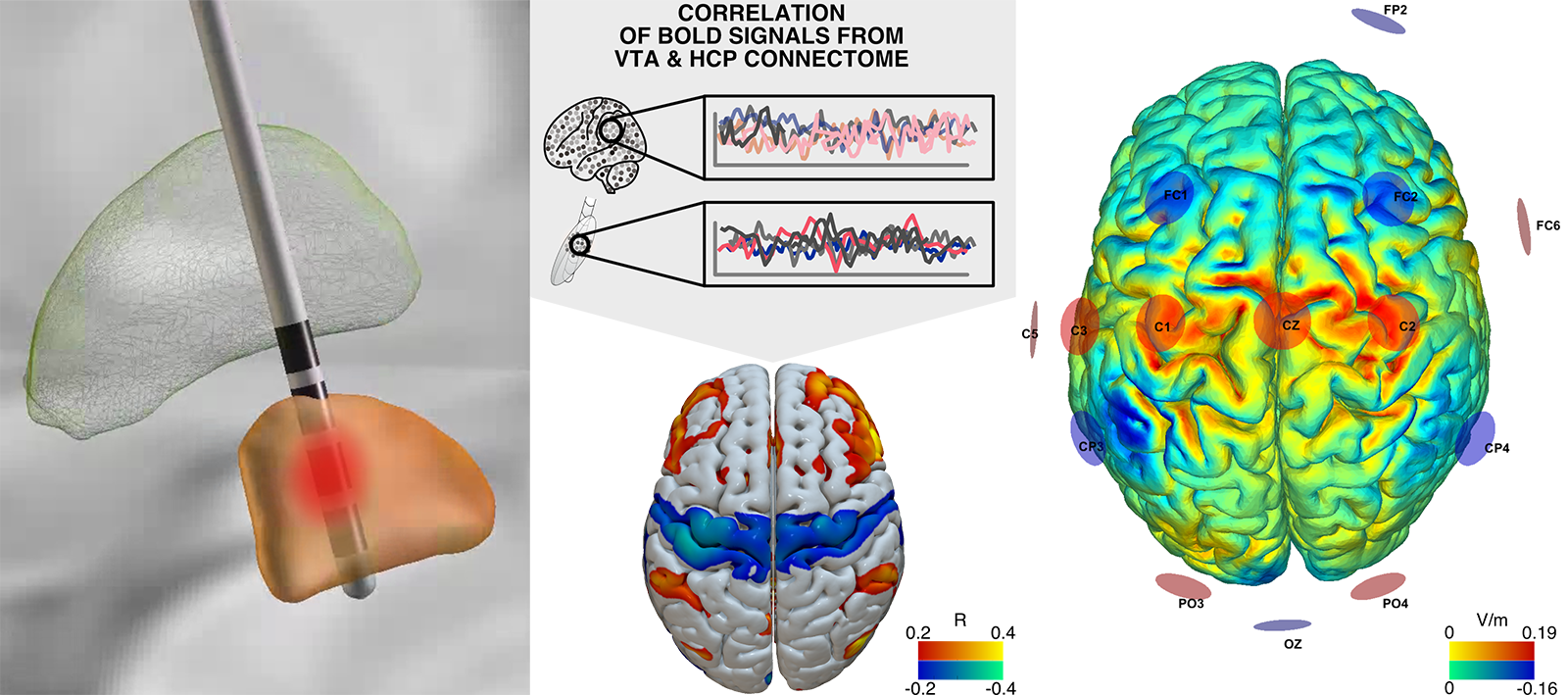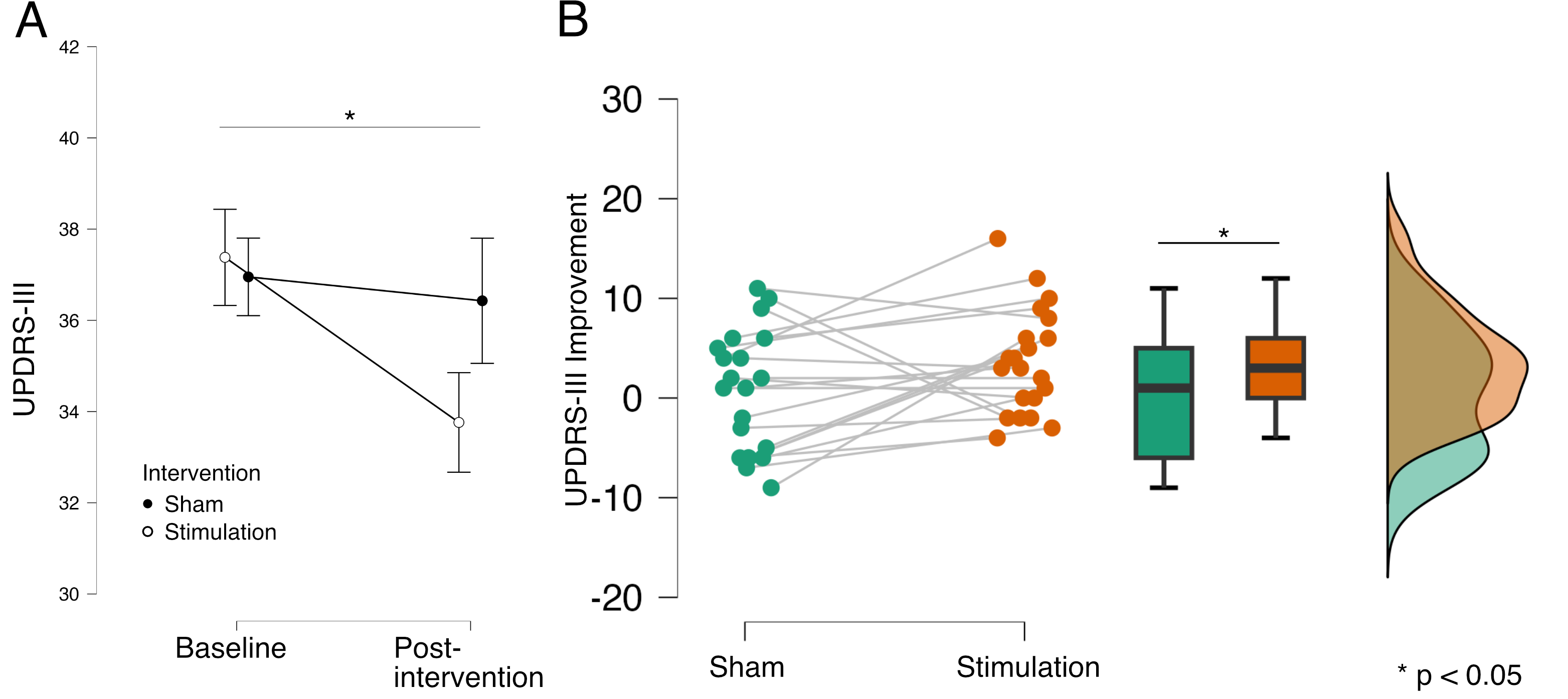Category: Parkinson’s Disease: Clinical Trials
Objective: To determine if non-invasive neuromodulation of a network previously identified through invasive neuromodulation could improve motor symptoms in Parkinson’s disease (PD).
Background: A recent study found that modulating specific connections in the brain using deep brain stimulation (DBS) can improve PD symptoms [1]. Multifocal transcranial direct current stimulation (tDCS), which modulates networks on a cortical level, offers a non-invasive method to target the same network [2].
Method: We carried out a prospective, double-blinded, cross-over trial with N=23 PD patients (mean age 59.9 years, mean H&Y 2.4). The montage for multifocal tDCS was based on the previously published network underlying DBS-effects in PD [1] [figure 1]. tDCS and sham was applied for 20 minutes on two consecutive days in a randomized order. UPDRS-III was obtained before and directly after the intervention (primary endpoint), and for an exploratory secondary endpoint also 60 minutes after stimulation.
Results: Before intervention, the cohorts had comparable average UPDRS-III scores of 37.38±12.5 (stimulation days) vs. 36.95±13.9 (sham days, p=0.63). After stimulation, scores reduced to 33.76±11.19 (average improvement of 3.62±5.29) which was lower than after sham (36.43±14.15, average improvement of 0.52±6.11). A repeated-measures ANOVA confirmed significance of these effects (main effect contrasting before and after stimulation (F(1,20)=4.35, p<0.05) and for the interaction with stimulation vs. sham (F(1,20)=4.21, p<0.05) [figure 2]). Tukey post-hoc analysis revealed that UPDRS-III improved after stimulation (t=2.9, p<0.03) but not after sham (t=0.42, p>0.05). Comparison of UPDRS-III improvements (pre vs. post intervention) revealed greater UPDRS-III improvement after stimulation compared to sham (t(20)=-2.05, p=0.03). 60 minutes after stimulation, scores partially recovered to an average of 33.91±12.65, resulting in an average improvement from baseline of 3.48±6.93.
Conclusion: Non-invasive multifocal tDCS applied to an a priori network identified by connectomic DBS led to significant motor improvements. Although effect sizes were small, this study provides proof of principle for successful non-invasive neuromodulation of the network. Repeated and longer tDCS applications may lead to greater and longer-lasting clinical effects.
References: 1. Horn A, Reich M, Vorwerk J, Li N, Wenzel G, Fang Q, et al. Connectivity Predicts deep brain stimulation outcome in Parkinson disease: DBS Outcome in PD. Ann Neurol. 2017;82:67–78.
2. Fischer DB, Fried PJ, Ruffini G, Ripolles O, Salvador R, Banus J, et al. Multifocal tDCS targeting the resting state motor network increases cortical excitability beyond traditional tDCS targeting unilateral motor cortex. NeuroImage. 2017;157:34–44.
To cite this abstract in AMA style:
L L. Goede, S. Oxenford, D. Kroneberg, G M. Meyer, N. Rajamani, C. Neudorfer, P. Krause, R. Lofredi, M D. Fox, A A. Kühn, A. Horn. Connectomic DBS informed multifocal transcranial direct current stimulation (tDCS) in Parkinson’s Disease: a crossover double blinded study [abstract]. Mov Disord. 2023; 38 (suppl 1). https://www.mdsabstracts.org/abstract/connectomic-dbs-informed-multifocal-transcranial-direct-current-stimulation-tdcs-in-parkinsons-disease-a-crossover-double-blinded-study/. Accessed December 5, 2025.« Back to 2023 International Congress
MDS Abstracts - https://www.mdsabstracts.org/abstract/connectomic-dbs-informed-multifocal-transcranial-direct-current-stimulation-tdcs-in-parkinsons-disease-a-crossover-double-blinded-study/


